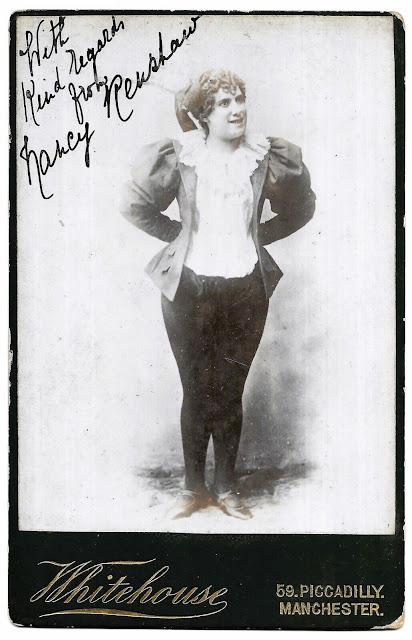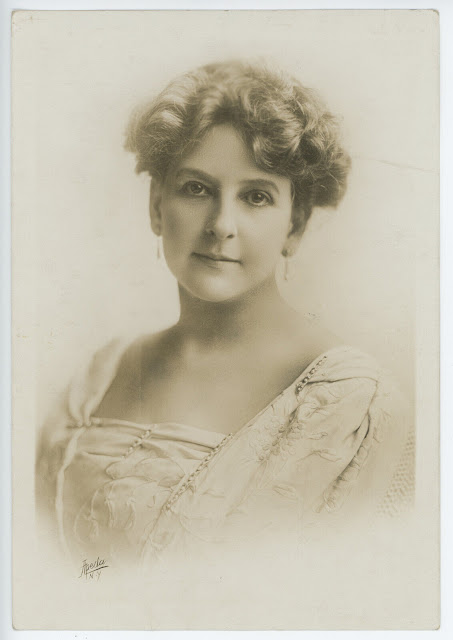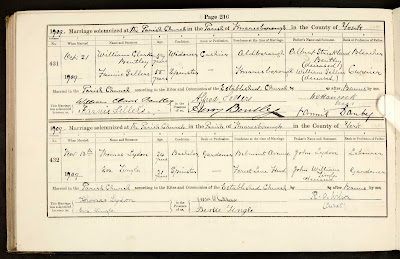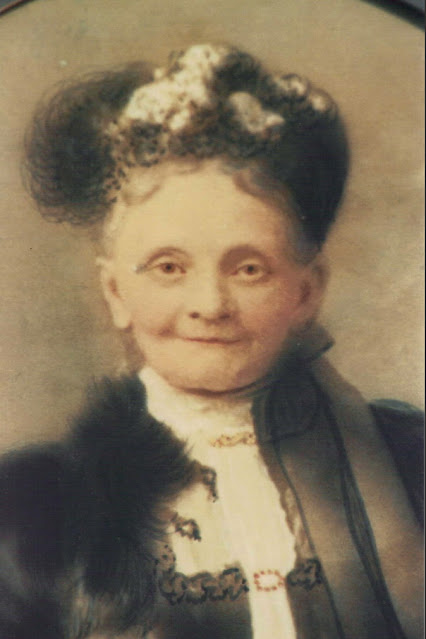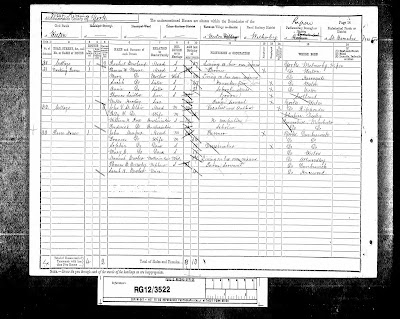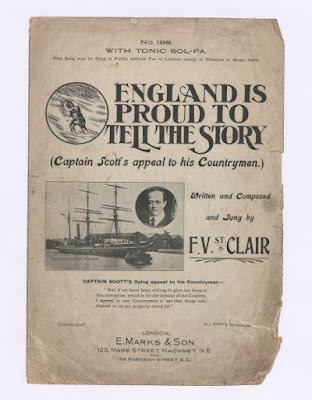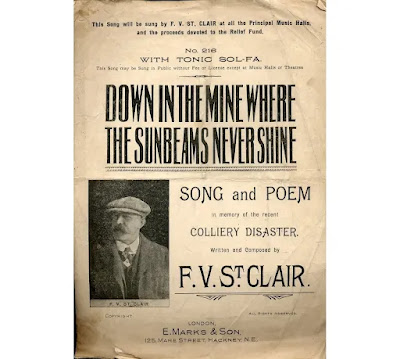I was sure I'd published this in one of my books. Maybe I did. But I'm in the Winter Palace, without my books, and only my memory ... and another site has a text which sounds oddly like 'Kurtspeak'. Then, I was sure I had photos, too ...
But google tells me I hav'n't posted Tom, so here goes ...
KARL, Tom ([O’] CARROLL, Thomas Louis) (b Dublin, 19 January 1846; d 51 Prince’s Street, Rochester, NY, 19 March 1916).
Tenor Tom Karl’s origins are strangely smudged. During his long and successful career on the American stage, it was established and enshrined in legal print that his name was, in fact, Carroll and that he was Irish born on the precise date above. However. I have found nothing to tell us who his family were, excepting for one sister, who came to live with him and his partner in later life. She, too, was a small-time musician, but not so as to be worth a change of name. And her name was Margaret A O’Carroll. So, take your pick. Or turn up that Irish birth certificate.
The story goes that Tom ‘went to England in his youth’. Presumably not too early in his youth, because I don’t find him in the censi of 1851 or 1861. And presumably not with his family, for I have evidence of Margaret (b c1850) as the local music teacher and organist in the settlement of Singleton, NSW, in 1871. So, it seems as if the (O’) Carroll family might have taken the goldrush trip to Australia and Tom stayed home. A Karl biographer, Charles Elliott Fitch, affirms that Margaret had been ‘36 years in Australia’ (in 1902), which would mean she arrived in 1866 … well, several Margaret Carrolls arrived in the colony in that year … but Fitch also ‘records’ some frank untruths, so, take your pick.
My first sighting of Thomas, then, is under his new name: ‘Tom Karl’. He had ended up in Birmingham, studying singing with Henry Phillips ‘for two years’ and made his first visible public appearance in May 1867, in the operatic selections at Day’s Crystal Palace Concert Hall, opposite no less a soprano than Annie Tonnellier. The local press reported of their delivery of an Il Trovatoreselection: ‘Mr T Karl, the new tenor, possesses a melodious and powerful voice which will shortly place him in the highest rank of the profession. He materially assists Madame Tonnellier in her splendid rendering of the grand scena from Trovatore…’.
Tom Karl and Annie were featured at Day’s through the rest of 1867 and into 1868, changing their opera to The Bohemian Girl (encored in ‘The Fair Land of Poland’), Martha (‘M’Appari’ ‘given in a particularly pleasing manner’), Maritana, The Barber of Seville, Faust, Don Giovanni, Acis and Galatea, Ernani, La Sonnambula … and Tom switched quickly from being billed as ‘the new tenor’ to ‘the popular tenor’.
He sang with the local Apollo Glee Club, and I spot him in concert at Birmingham’s Curzon Hall … and then he is gone. To Italy. To study with, of course, Sangiovanni.
The usual biographical notes – notably Fitch -- claim ‘he remained seven years’ which is patent rubbish. There are other silly statements, too: he was selected by Petrella to create La Contessa d’Amalfi (which was created in 1864) or I Promessi sposi … he wasn’t. However, his first appearance on the stage was seemingly in a production of the well-established La Contessa d’Amalfi in May of 1869. I don’t know where, but the contemporary press related that he had been a late replacement and had had but 8 days to learn the role.
And a few weeks later, he was home, singing Mozart’s 12th Mass in a Birmingham church, and visiting Dublin in concert (‘Spirto gentil’, ‘My Mary of the curling hair’, ‘Dear Harp of my Country’). It was but a brief visit, however. For on 18 August he was back in Italy, as a member of the summer-season troupe at the Teatro Goldoni, Modena, repeating La Contessa d’Amalfi alongside Clarice Ziska. By October he was in Malta, singing Arturo in I Puritani.
Over the next year or so, Tomasso Karl can be seen at Milan’s Teatro Re in Lallah Rookh (Noureddine) and La Contessa d’Amalfi, at La Scala for the one performance that was the lot of Beer’s Elisabetta d’Ungheria (Giorgio), and at the Carcano in I promessi sposi (Renzo). There were doubtless other engagements in the period, but these are all that I can find.
For Tom Karl’s next engagement was to be in America. The young man ‘said to be the Adonis of British tenors; fresh from Italy’ (although the press claimed his last engagement had been in Malta) was hired to share the tenor roles in the Parepa Rosa Company with William Castle, in a troupe including Jennie van Zandt, Edward and Zelda Seguin and the Aynsley Cooks. He made his first appearance in America – mendaciously advertised as having been ‘a favourite at La Scala for three years’ --as Tonio in La Fille du régiment and ‘despite nervousness made a favourable impression’. ‘There can be no doubt of his success. He is young, good looking and prepossessing in manner. His voice is light but by no means weak. It lacks the sensuous quality of the best Italian tenors but it is a clear, bright and withal rather sweet voice, singularly even, and lending itself readily to pathetic strains…’
Karl played Don Ottavio in Don Giovanni and Gennaro in Lucrezia Borgia opposite Parepa, and when the company was strengthened by the addition of Wachtel and Santley, Alphonse in Zampa and the Fisherman in William Tell, as well as second to Castle as Florestein in The Bohemian Girl and Antoni in The Water Carrier.
Then promptly, at the season’s end, he boarded the Cuba to return to Britain and to Europe. During the carnevale of 1872 and the early months of 1873, he can be seen playing at the Teatro Paganini in Genoa (Romeo e Giulietta), then at the Teatro della Commedia, Milan and at the Rossini, Turin, in L’Ombra with Mme Repetto-Suardi, but by the autumn he is back in America ‘visiting friends in Worcester’. Italy was over, and henceforth Tom Karl would settle down and make his home and career in America.
I don’t know at exactly what stage Tom encountered publisher and bookseller’s son, Dellon Marcus Dewey, from Rochester NY. Probably not just yet, as Dewey (b August 1850) was pretty young, and still living at home. But by 1880, Tom had moved in to the substantial Dewey home as well, then the two lads moved out together. They would stay together until death did them part, in 1916.
Tom was soon on the road, performing with a concert party headed by violinist Camilla Urso, and including Edith Abell and J R Thomas in the last months of 1873. In 1874, he was attached to the Strakosh Opera Company, stars Lucca, Campanini, Nilsson, Capoul et al, with whom he sang Don Ottavio and Gennaro during the opera season, second to Capoul in the Stabat Mater and, afterwards, in various concerts featuring Lucca and Annie-Louise Cary, ending in Boston 20 June.
He then picked up with several members of a collapsed English opera troupe, including Miss Abell and Frank Howson, for a concert tour of Canada. However, this was only a fill-in, as he was already engaged to be principal tenor with the Adelaide Phillipps touring opera, which went out in the autumn.
The Phillipps company had a repertoire adapted to its mezzo-soprano star, and Tom sang during the season the tenor leads in Cinderella, The Barber of Seville, Il Trovatore, Martha, La Favorita, Don Pasquale and L’Ombra. However, the company disbanded when its tenor allegedly fell ill in Hannibal, Mo.
In 1875, the star soprano Therese Titiens visited America and Tom Karl became attached to her service, along with baritone Orlandini. They appeared in concert and in opera, with Karl sharing the tenor roles (Pollio, Alfredo) with the lustier Brignoli.
In 1876, he again went out for several months with Miss Phillips, now sharing the tenor duties in Semiramide, Le Comte Ory, La Favorita, Il Trovatore &c with Tito Palmieri. When he sang Almaviva to Ferranti’s Figaro, the New York press voted him ‘the best representative of Count Almaviva before the public’. At the end of Miss Phillipps’s season, Strakosh teamed him, in the same role, with his newest prima donna contralto, Anna Belocca, before sending the pair, with basso Tagliapietra, to California. There they gave concerts, and, with the conjunction of resident basso Karl Formes, The Barber of Seville and La Favorita.
In October, they played another season in New York.
In 1877, after a short concert tour with Ole Bull, Tom Karl signed up with Strakosh’s Clara Louise Kellogg opera company, sharing the tenor duties with J Graff, alongside Miss Cary, Marie Roze, William Carleton, basso Conly et al. And, intermittently, Ilma di Murska. Leaving the Manricos and Lucias to Graff, he sang Lionel, Faust, Thaddeus, Elvino, Wilhelm Meister, Don Ottavio et al and, once again was praised for his ‘skill in light opera’. ‘He compensates for a not superior voice by skill in using it, singing always with taste and expression, and can always to be relied on to act and look well…’, ‘Mr Karl never attempts more than he can do, and always does well what he attempts … a smooth and pleasant tenor voice well adapted to the lighter tenor arias while unequal to the more robust. He is an excellent actor and in La Sonnambula and other operas his rendition was worthy of high praise’. However, he did go on as Rhadames, on at least one occasion.
The tour was decidedly successful, even if it spawned some fairly silly press stories, the silliest of which was a publicist’s floater rumouring a marriage between Tom and Miss Kellogg. Mocked by the papers, it quickly was denied. The other had Tom, in Mignon, rescuing Ms Roze from the flames, but being not strong enough to lift her, he had to get the help of the baritone. That piece of publicity was provincial newspaper fodder for far too long, and survived into anecdotic books.
After some concerts with Marie Roze, in late 1878, Karl joined up again with Adelaide Phillipps, alongside soprano Marie Stone and baritone W H Macdonald. Lucia di Lammermoor, Il Trovatore and Martha gave way in April to the newest operatic sensation, HMS Pinafore, with the artists who had been singing Donizetti and Verdi cast in the ‘Boston Ideal Opera Company’: Miss Phillipps as Buttercup and Karl as Ralph Rackstraw. The production, and its follow-up of Fatinitza, with Miss Phillipps as the title hero and Karl as the comical Julian, laid the foundation for what would become the most famous light opera company in American theatre history.

But its first season was just that, a season and, in the autumn, Tom moved on to his next job, sharing the tenor duties with Castle in Messrs Pratt and Morrisey’s Emma Abbott Opera Company. He sang Don Jose to Zelda Seguin’s Carmen, Tonio, Grénicheux and some performances as Paul in Paul and Virginia and Baltimore declared ‘he stands at the head of tenor singers in this country’.
Then, it was back to the Ideals, with a repertoire expanding to include the part of Frederic in The Pirates of Penzance.
In 1881 (September 28) he made what was announced as ‘his debut in oratorio’ at the Worcester Festival, but the Ideal company’s success had truly blossomed and, for the next years, Tom Karl’s popularity, all round America, blossomed too, as they played Czar and Carpenter, The Chimes of Normandy, The Mascot, Olivette, The Musketeers (Varney), Barbe-bleue, Giralda, Victor the Bluestocking and Giroflé-Girofla ,as well as the Gilbert and Sullivan operas and more conventional operas such as The Marriage of Figaro, The Bohemian Girl, Adina (L’Elisir d’amore), Fra Diavolo, Mignon or Martha, from one corner of America to another.
The management of the troupe suffered sea-change during this time, and in 1887 Tom Karl and Henry C Barnabee (to be supplemented by W H Macdonald) became officially its owners.
The Bostonians, as they subsequently were known, continued in much the same way as before -- The Poachers, Dorothy. Pygmalion and Galatea, Don Pasquale, but also began to produce home-made comic operas. In 1887, the company had been hired for a vanity production of Signor Alfredo Jannotta’s Alidor at St Paul, now they mounted a Suzette by company conductor Oscar Weil, and a Don Quixote by the wealthy Reginald de Koven. Karl was apparently singing as well as ever, but he was now sharing the tenor roles in the company’s productions with Edwin Hoff and it was announced that he had ‘a tumour in the throat’. Nodules, I suspect. From singing Manrico.
The American theatro-gossip press, which had him returning to the Emma Abbot company, among other things, was silenced when the Bostonians had their biggest hit since Fatinitza with the production, in 1890, of de Koven’s Robin Hood, with Tom Karl in the title-role. Robin Hood would become the backbone of the company’s repertoire in the 1890s. However, in 1894, Tom Karl sold his interest in the Bostonians to his partners, and at nigh fifty years of age, retired.
He would appear again in concert on numerous occasions – in New York, at Vineyard Haven, where he and Dewey had a summer home, even on one occasion with a ‘Tom Karl concert party’, before in 1905 the couple moved their home to California. They put together a light opera troupe, which they called The Californians, but in spite of being made up of sound artists, it lasted but one season, and in 1909 Karl, Dewey and Margaret (now arrived from Australia) shifted back east.
Fitch recounts that his last stage performance was in Patience in Rochester, for charity, in 1913, and his last public performance ‘in 1915 over the wires of the Trans-Continental Telephone Company when, at a dinner of the Rotary Club, he sang to be heard in San Francisco where his voice was distinctly audible to those who had often listened to him on the opera stage in that city. The song that went over the three thousand miles of wire was the old English ballad ‘Drink to Me Only With Thine
Eyes’.’
Tom Karl died in 1916. Dellon ‘removed to New York’ but died at the home of his sister, Fannie, 29 July 1917.
Fitch concluded with a sigh: ‘there were few better tenors than Tom Karl and no singer ever surpassed him in personal charm or popularity with the music loving public of this country, Italy or England’.

